Martienssen W., Warlimont H. (Eds.). Handbook of Condensed Matter and Materials Data
Подождите немного. Документ загружается.

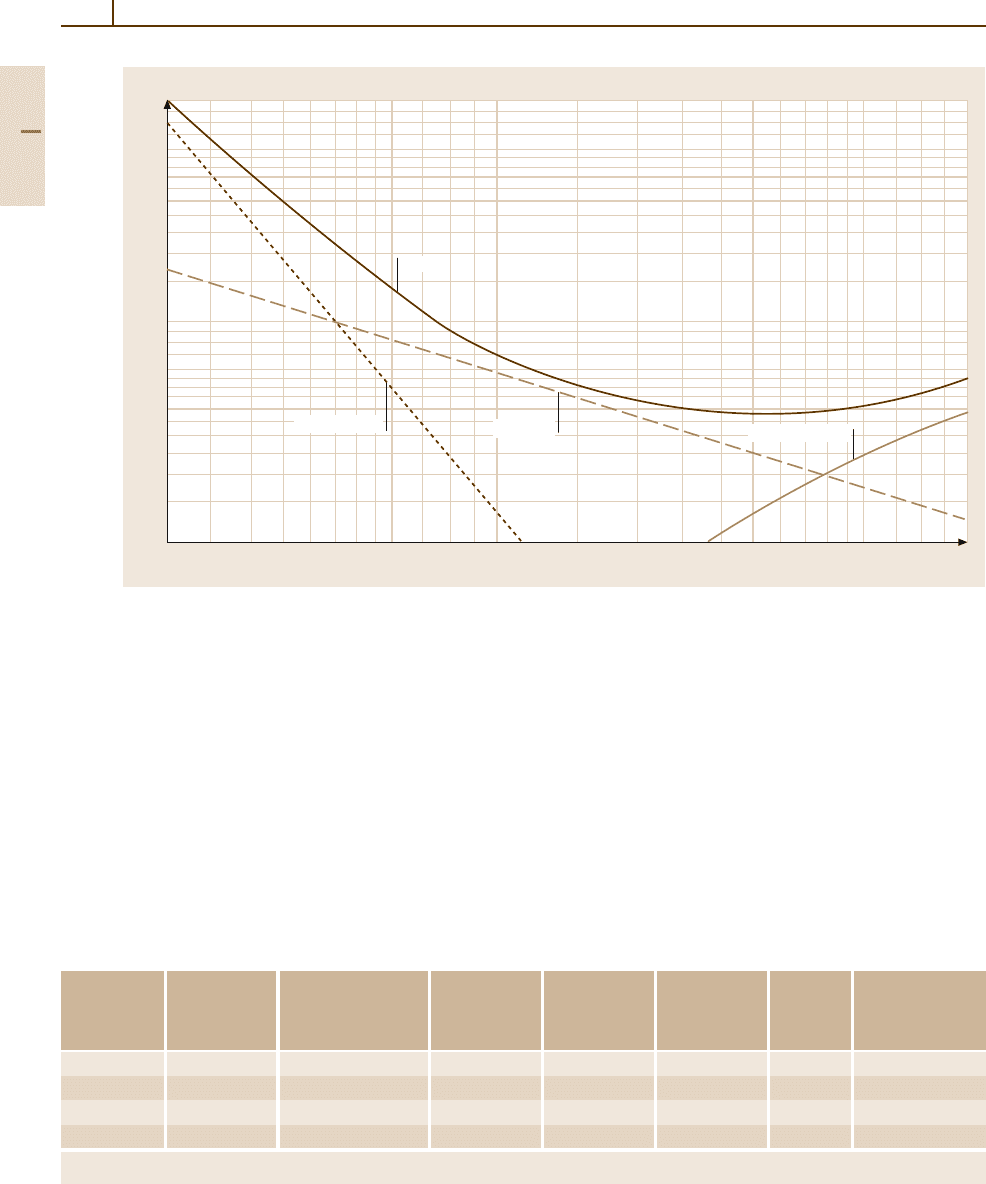
412 Part 3 Classes of Materials
1.0
0.9
0.8
0.7
0.6
0.5
0.4
0.3
0.2
0.1
0.09
0.08
0.07
0.06
0.05
0.04
0.03
0.02
0.01
0.2 0.4 0.6 0.8 1 2 4 6 8 10
Attenuation coefficient
Gamma energy (MeV)
Total
Photoelectric
Compton
Pair production
Fig. 3.1-353 Gamma-ray mass-absorption coefficients for lead [1.299,305]
3.1.11.2 Pb–Sb Alloys
Pb–Sb Binary Alloys
Lead–antimony alloys are widely used for pipe, cable
sheathing, collapsible tubes, storage battery grids, an-
odes, sulfuric acid fittings, and X-ray and gamma ray
shielding (in the absence of neutron irradiation). The ad-
dition of 1 to 13 wt% Sb to Pb increases tensile strength,
fatigue strength, and hardness compared to pure lead
(99.99). Lead and Sb form a eutectic system as shown in
Fig. 3.1-354 [1.303]. The maximum solubility of Sb in
Pb is 3.45 wt% at the eutectic temperature and decreases
to 0.3wt% at 50
◦
C. Thus considerable age-hardening
Table 3.1-278 Physical properties of Pb
−
Sb alloys [1.300]
Alloy Solidification Coefficient of Specific heat Thermal Resistivity Density Volume change
composition range thermal expansion conductivity on freezing
a
(wt%) (
◦
C) (10
−6
K
−1
) (Jkg
−1
K
−1
) (Wm
−1
K
−1
) (n m) (gcm
−3
) (%)
Pb–1 Sb 322–317 28.8 131 33 11.27 −3.75
Pb–3 Sb 310–269 28.1 11.19
Pb–6 Sb 285–252 27.2 135 (solid) 29 253 10.88 −3.11
Pb–9 Sb 265–252 26.4 137 (solid) 27 271 10.60 −2.76
a
Negative values show contraction
can be obtained in these alloys. Small additions of As
(0.05–0.1 wt%) dramatically increase the rate of aging
and final strength. The microstructure at higher Sb con-
tents consists of proeutectic lead-rich phase surrounded
by a network of eutectic phase that contributes to en-
hanced as-cast and high temperature strength. Shrinkage
on solidification varies from 3.85% for Pb to 2.06% for
a Pb–16wt% Sb alloy. These alloys have high corrosion
resistance in most environments. They form a protective
and impermeable film faster than pure lead and, in some
cases, even faster than chemical lead. Table 3.1-278 lists
the physical properties of selected Pb
−
Sb alloys [1.300].
Table 3.1-279 lists the mechanical properties of cast
Part 3 1.11
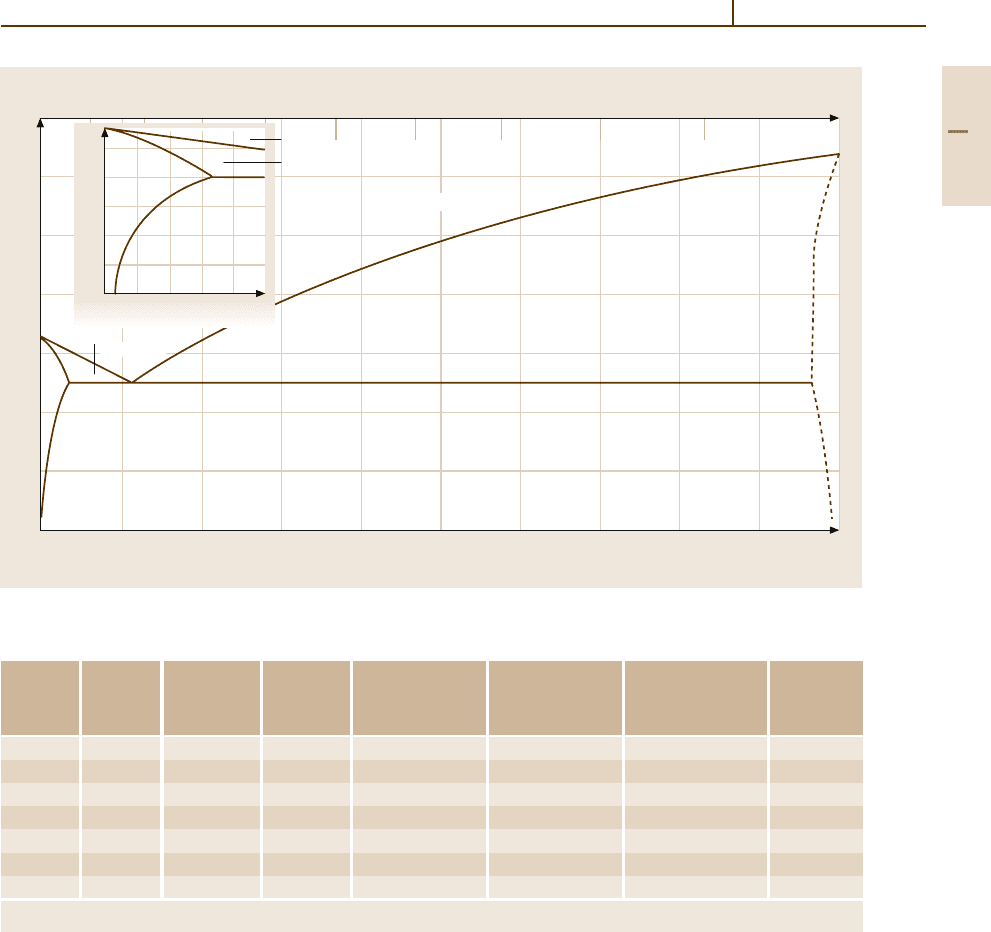
Metals 1.11 Lead and Lead Alloys 413
700
600
500
400
300
200
100
0
0
Antimony (at.%)
10 20
Antimony (wt%)
30 40 50 60 70 80 90 100
0 102030405060708090100
Pb
Sb
300
200
100
°C
012345
(% Sb)
T(°C)
α
α+β
3.45
Liquid
Liquid
+α
Liquid
+α
α
3.45 11.1
327°C
0.3 (50°C)
252 °C
Liquid
Liquid
+β
α+β
630°C
?
β
?
95.5
Fig. 3.1-354 Pb
−
Sb phase diagram [1.303]
Table 3.1-279 Mechanical properties of Pb
−
Sb alloys [1.299–301,306]
Sb Tensile Elongation Hardness Yield Fatigue strength Creep Young’s
content
strength at fracture strength R
p0.125
for 2 × 10
7
cycles strength modulus
(wt%)
(MPa) (%) HB (MPa) (MPa) (GPa)
1(a)37.9 20 19.3 7.6 190 h at 20.7MPa −
1(c)20 50 7.0 − 7.6 −
3(a)65.5 10 55.2 − 630 h at 27.6MPa −
3(c)32.43 15 9.1 −
6(a)73.8 8 71.0 1000 h at 27.6MPa
6(c)47 24 13 17.2 24.15
6 (r) 29.6 42 8.7 15.2 10.3 − −
(c) cast; (a) cast and stored 30 days at room temperature; (r) rolled
alloys [1.299–301, 306]. Data for one of the rolled al-
loys are also given to indicate that they exhibit poorer
properties.
Pb–Sb-Based Lead Acid Battery Grid Alloys
Lead–acid batteries are the most widely used secondary
battery type in current automotive and industrial applica-
tions due to the relatively low cost and high availability
of the raw materials, room temperature operation, ease
of manufacture, long life cycle, versatility, and the ex-
cellent reversibility of the electrochemical system. Lead
alloys are used as electrode grids, connectors, and grid
posts. The two classes of alloys that are in extensive use
are (i) Pb
−
Sb based ternary and multi-component al-
loys with As, Sn, Ag, Se, Cu, S, and Cd and (ii) Pb
−
Ca
based ternary alloys and multi-component alloys with
Sn, Ag, and Al. In the Pb
−
Sb based alloys, Sbaddition to
Pb enhances castability, tensile strength, creep strength,
corrosion resistance under battery operating conditions,
and resistance to structural changes during deep charge–
Part 3 1.11

414 Part 3 Classes of Materials
discharge cycling. However, Sb migration from Pb
−
Sb
based positive grid alloys to negative electrode results
in the reduction of hydrogen over-voltage and conse-
quent decrease in cell voltage. This led to increased
degassing and water loss. To minimize this poisoning
of negative plates, lower Sb contents (1–3 wt% Sb) are
now used in battery grids. The posts and straps use
about 3 wt% Sb. Low Sb content promotes the forma-
tion of solidification shrinkage porosity and cracking
but the cracking tendency is overcome by the use of
grain-refining additions of S, Cu, and Se. Arsenic addi-
tions to Pb
−
Sb alloys increase the rate of age-hardening
and reduce the time of grid storage required after cast-
ing. Arsenic addition also increases the creep resistance
which is very beneficial in deep cycling conditions. The
addition of tin is used to act synergistically with As
and Sb to improve fluidity and castability. It also in-
creases cycle life of deep cycling batteries containing
thin plates. Silver additions increases both the corro-
sion and creep resistance in Pb
−
Sb alloy grids. Cast
Pb
−
Sb based alloys are typically used in grid alloys
as the Pb
−
Sb based wrought alloys have lower yield
strength, tensile strength, and creep strength. The cor-
rosion behavior of wrought alloys is inferior due to the
nature of distribution of the PbSb eutectic phase and
lower creep resistance. Corrosion of cast Pb
−
Sb occurs
by the attack of Pb
−
Sb eutectic. It solubilizes some Sb
and stresses of corrosion product are accommodated. In
rolled alloys the eutectic phase is isolated, which leads to
stresses in the grid. The current choice of alloy composi-
tion is Pb
−
1.6Sb
−
0.2As
−
0.2Sn
−
0.2Se. Table 3.1-280
Table 3.1-280 Alloying components of common lead–
antimony battery grid alloys [1.300,307]
Alloy concentration (wt%)
Sb
Sn As Cu Se
2.75 0.2 0.18 0.075 −
2.75 0.3 0.3 0.075 −
2.9 0.3 0.15 0.04 −
2.9 0.3 0.15 0.05 −
1.6 0.2 0.2 − 0.2
Table 3.1-281 Typical compositions and properties of selected type metals [1.299,300]
Alloy Composition (wt%) Hardness HB Liquidus temperature Solidus temperature
Pb Sn Sb (
◦
C) (
◦
C)
Electrotype – General 94 3 3 14 299 245
Linotype – Special 84 5 11 22 246 239
Stereotype – Flat 80 6 14 23 256 239
Monotype – Ordinary 78 7 15 24 262 239
lists the compositions of common lead–antimonybattery
grid alloys [1.300,307].
Lead–antimony alloys containing 0.2to1wt%Sb
are used to form barrier sheaths in high voltage cables.
Properties of Pb
−
0.85Sb cable sheathing alloy are pre-
sented in the section on cable sheathing alloys. Lead
alloys with 6–8 wt% Sb are used to fabricate a wide va-
riety of equipment such as tank linings, pipe and one
type of anode used in chromium plating. Alloys with
13 wt% Sb are used to make castings when hardness is
of key importance. About 6% of the Pb produced in the
world was used in the production of sports and military
ammunition due to its high density and low cost. Lead
containing up to 8 wt% Sb and 2 wt% As is used.
Pb–Sb–Sn Alloys
These alloys have low melting points, high hardness,
and excellent high temperature strength and fluidity.
These characteristics together with its applicability for
the replication of detail make them suitable as printing
types. Table 3.1-281 lists the characteristics of selected
type-metal alloys [1.300].
The Pb-rich ternary Pb
−
Sb
−
Sn white metal alloys
are also used in journal bearings due to the excellent
anti-friction (and anti-seizure) characteristics and hard-
ness. These Pb-rich white metal alloys, also referred to
as Babbit alloys, contain 9–15 wt% Sb, 1–20 wt% Sn,
and small amounts of Cu and As. Table 3.1-282 lists the
physical properties of different bearing alloys [1.299,
300]. The mechanical property data for some of these
alloys are presented in Table 3.1-283 [1.299,308]. Most
of the alloys lie in the primary crystallization field of
Sb or SbSn of the ternary system. They contain pri-
mary crystals of Sb (or SbSn) in a binary (or ternary)
eutectic matrix apart from the high-melting Cu-rich
phases. Copper contents above 1.5 wt% also increase
the hardness. Arsenic addition leads to a fine and uni-
form structure, improvesfatigue strength, and minimizes
softening. Arsenic is present in solid solution in Pb, Sb,
and Sb-containing phases such as SbSn. The lead–alkali
alloys, e.g., Bahnmetall, or the Pb
−
Sn
−
alkali alloys,
also have a limited significance as bearing metals.
Part 3 1.11

Metals 1.11 Lead and Lead Alloys 415
Table 3.1-282 Composition and physical properties of selected lead-based white metal bearing alloys [1.299,300]
Alloy composition Freezing Density Vol um e Coefficient Specific Latent Electrical Thermal
(wt%)
range change on of thermal heat heat resistivity conductivity
freezing
a
expansion of fusion
Sb Sn (
◦
C) (gcm
−3
) (%) (10
−6
K
−1
) (Jkg
−1
K
−1
) (kJkg
−1
) (n m) (Wm
−1
K
−1
)
9.5–10.5 5.5–6.5 256–240 10.50 −2 150 0.9 287
14–16 4.5–5.5 272–240 9.96 −2 24 150 0.1 282
14–16 9.3–9.7 268–240 9.70 −2.3 19.6 160 286 24
14.5–17.5 0.8–1.2 353–247 10.10 −2.5
a
Negative values show contraction
Table 3.1-283 Composition and mechanical properties of ASTM B23 Pb-based white metal bearing alloys [1.299,308]
Alloy Nominal alloy content (wt%) Yield stress Elongation Ultimate strength Hardness Melting Fatigue
no.
(MPa) at fracture in compression HB 500/30 range strength
(%) (MPa) 2×10
7
cycles
Sb Sn Cu As 20
◦
C 100
◦
C 20
◦
C 20
◦
C 100
◦
C 20
◦
C 100
◦
C (
◦
C) (MPa)
7 15 10.0 <0.5 0.45 24.5 11.0 4 107.9 42.4 22.5 10.5 240–268 28
8 15 5.0 <0.5 0.45 23.4 12.1 5 107.6 42.4 20.0 9.5 237–272 27
15 16 1.0 <0.5 0.8–1.4 2 21.0 13.0 248–281 30
3.1.11.3 Pb–Sn Alloys
Lead-tin alloys serve as materials for a number of appli-
cations as summarized in Table 3.1-284.
The Pb
−
Sn system (Fig. 3.1-355) shows an extended
and strongly temperature-dependent solid solubility of
Sn in Pb decreasing from 19.2 wt% at the eutectic tem-
perature to about 1.3 wt% Sn at room temperature. This
can lead to significant age-hardening on rapid cooling
from the range of the homogeneous α phase. Streaky and
granular Sn precipitates lead to hardness increases from
about HB = 4 in pure lead to around HB = 12 at the
solid solubility limit. In the stable α +β range hardness
increases less rapidly to about HB = 18 at the eutectic
composition.
Table 3.1-284 Applications and typical compositions of Pb
−
Sn materials
Application Alloying elements (wt%) Remarks
Sn Others
Cable sheathing <0.5 Sb (0.2), Ca (0.33) or Cd (0.15)
Solders 2–63 See below
Pressure die castings ∼62 (near eutectic)
Organ pipes (45) 55–74
Sliding layer on bearings 10–20 5Cu Electroplated
Type metals 3–12 Sb (3–25) See Table 3.1-281
Terne steel coatings 12–20 Corrosion protection
Anodes 7 Cr plating
Pb–Sn-Based Solder Alloys
Lead–tin alloys in the Pb-rich hypoeutectic region are
the most widely used of all solders. In the melt, the sur-
face tension increases with Sn content. Table 3.1-285
gives the melting characteristics of some Pb
−
Sn solders
and lists their typical applications. When referring to
Pb
−
Sn solders, the Sn content is customarily given first,
for example 40/60 refers to 40 wt% Sn and 60 wt% Pb.
Table 3.1-286 summarizes the mechanical and physi-
cal properties of different soft solders [1.309]. Further
alloying additions are Cd, Bi, Sb, and Ag. Silver is
added to increase tensile, creep, fatigue, and shear
strengths, and to reduce the dissolution of Ag from
Ag alloy coatings. Addition of 5 to 6% in Sn con-
tent increases the tensile and creep strengths. Addition
Part 3 1.11
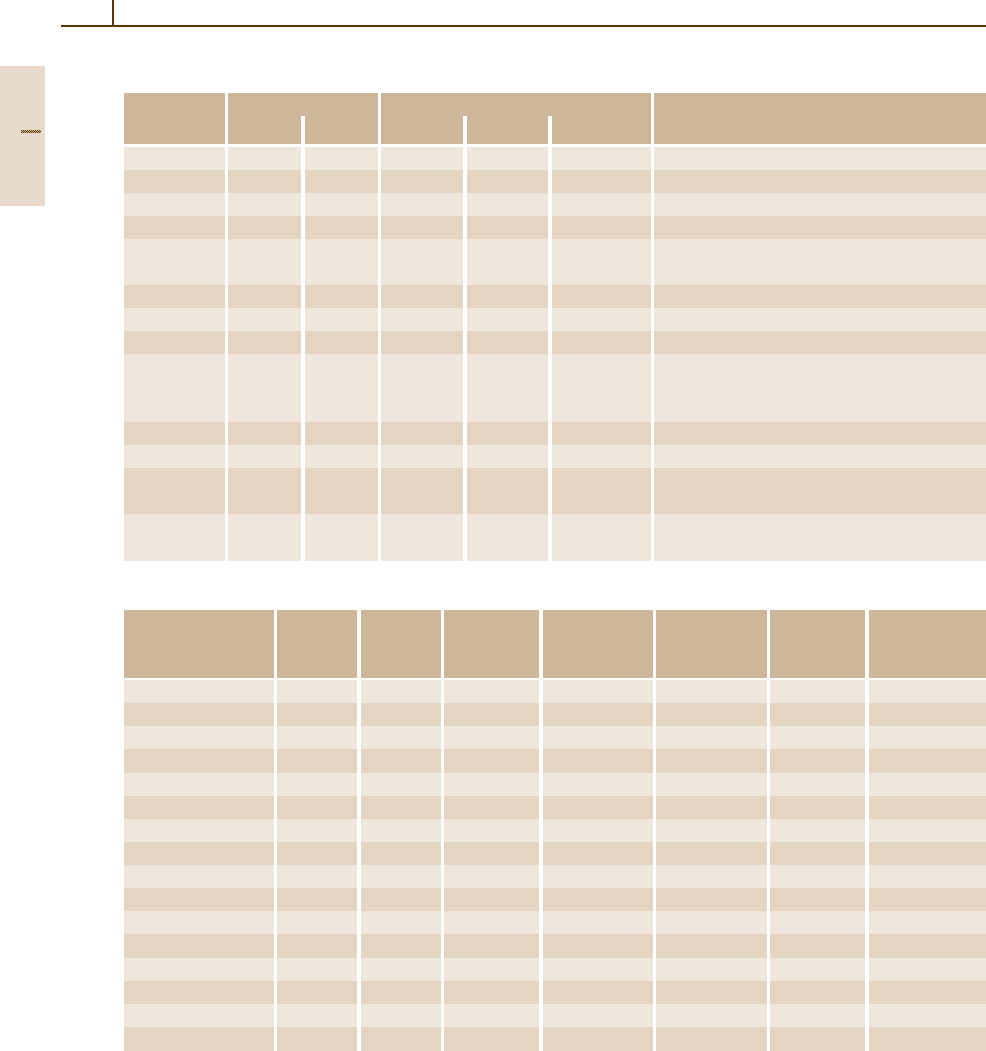
416 Part 3 Classes of Materials
Table 3.1-285 Melting characteristics and applications of Sn
−
Pb solders [1.309]
Solder alloy Composition (wt%) Temperature (
◦
C)
Sn/Pb Sn Pb Solidus Liquidus Pasty range Uses
2/98 2 98 316 322 10 Side seams for can manufacture
5/95 5 95 305 312 13 For coating and joining metals
10/90 10 90 268 302 62 For coating and joining metals
15/85 15 85 227 288 110 For coating and joining metals
20/80 20 80 183 277 170 For coating and joining metals. For filling dents
or seams in automobile bodies
25/75 25 75 183 266 150 For machine and torch soldering
30/70 30 70 183 255 130 For machine and torch soldering
35/65 35 65 183 247 116 General purpose and wiping solder
40/60 40 60 183 238 99 Wiping solder for joining lead pipes and cable
sheaths. For automobile radiator cores and heating
units
45/55 45 55 183 227 80 For automobile radiator cores and roofing seams
50/50 50 50 183 216 60 For general purpose. Most popular of all
60/40 60 40 183 190 13 Primarily used in electronic soldering applications
where low soldering temperatures are required
3/37 63 37 183 183 0 Lowest melting (Eutectic) solder for electronic
applications
Table 3.1-286 Physical and mechanical property data on Pb–Sn solders [1.309]
Material Tensile Shear Density Brinell Electrical Young’s Surface tension
strength strength hardness HB conductivity modulus (290
◦
C)
(wt%)
(MPa) (MPa) (gcm
−3
) (% of σ
Cu
) (GPa) (10
11
Nm
−1
)
Pb 12.30 12.44 11.34 4.0 7.9 18.04
5/95 Sn/Pb 28.96 20.73 11.06 9.0 8.0
10/90 Sn/Pb 32.48 26.96 10.44 11.0 8.2 19.08
15/85 Sn/Pb 34.56 30.89 10.50 11.3 8.4
20/80 Sn/Pb 35.94 32.76 10.23 11.5 8.7 20.04 467
25/75 Sn/Pb 37.32 36.70 10.00 11.5 8.9
30/70 Sn/Pb 39.74 38.01 9.74 11.3 9.3 21.08 470
35/65 Sn/Pb 41.82 38.64 9.50 11.0 9.8
40/60 Sn/Pb 42.85 39.26 9.29 10.5 10.1 23.08 474
45/55 Sn/Pb 42.85 39.53 9.08 10.6 10.4
50/50 Sn/Pb 44.58 40.57 8.88 11.0 10.9 476
60/40 Sn/Pb 44.23 39.40 8.51 12.0 11.3 30.07
63/37 Sn/Pb 46.31 41.88 8.41 12.0 11.5 490
62Sn/36Pb/2Ag 46.31 43.20 8.42 16.0 11.6 23.57
10Sn/88Pb/2Ag 33.87 29.72 10.75 12.0 8.4 19.35
1Sn/97.5Pb/1.5Ag 24.88 24.88 11.28 11.0 8.8
of 0.18 wt% Cu causes a further increase. Bismuth-
containing solders, the so-called fusible alloys, are used
for low temperature soldering and are discussed in the
section on fusible alloys. Alloys of Pb
−
In are primar-
ily used for soldering at low temperatures and where
reduction in gold-scavenging is desired. They are also
extremely ductile, making them suitable for use in
areas where there is a thermal mismatch. Composi-
tions of other commonly used Pb solders are given in
Table 3.1-287 [1.309].
Part 3 1.11

Metals 1.11 Lead and Lead Alloys 417
350
300
250
200
150
100
50
0
19.2
0 10 20 30 40 50 60 70 80 90 100
Tin (wt %)
0 102030405060708090100
Pb Sn
61.9 97.5
T(°C)
327 °C
183°C
232°C
α
β
Tin (at.%)
Fig. 3.1-355 The Pb
−
Sn binary phase diagram [1.303]
3.1.11.4 Pb–Ca Alloys
The Pb
−
Ca and Pb
−
Ca
−
Sn alloys are used in storage
battery grid, pipe, wire, cable sheathing, anodes, chem-
ical handling equipment, radiation shielding, and other
applications [1.299]. Calcium is also used as a secondary
additive in hardened lead-bearing metals. Its solubil-
ity in Pb decreases from 0.1 wt% Ca at 328.3
◦
Cto
∼ 0.01 wt% Ca at room temperature (Fig. 3.1-356) and
pronounced age-hardening can be obtained. A peritectic
400
300
200
100
0
0 0.2 0.4 0.6 0.8
0 0.05 0.10 0.15
700
600
500
400
300
Ca (at.%)
0 5 15 25 40
Ca (wt%)
02
4
610
Pb
T(°C) Ca (at.%)
Ca (wt %)
0.07
0.1
328.3°C
327.3°C
~ 0.01
α
α + Ca Pb
3
630°C
327°C
CaPb
3
a) b)
Fig. 3.1-356 Pb-rich portion of the Pb
−
Ca phase diagram [1.303]
Table 3.1-287 Other common Pb-alloy solders [1.309]
Composition (wt%) Temperature (
◦
C)
Pb
Sn Ag In Solidus Liquidus Pasty range
97.5 1 1.5 − 309 309 Eutectic
36.0 62 2.0 − 179 189 18
97.5 − 2.5 − 304 304 62
50 − 50 124 209 52
92.5 − 2.5 5 285 305 36
reaction involving liquid Pb
−
Ca and Pb
3
Ca to form the
α-Pb–0.1 wt% Ca phase occurs at 328.3
◦
C [1.303]. At
> 0.07 wt% Ca, Pb
3
Ca crystallizes directly on solidifi-
cation. At > 0.1 wt% Ca, the microstructure consists of
primary crystals of Pb
3
Ca and a Pb matrix with finer
Pb
3
Ca precipitates. The two-phase structure present
at these higher Ca contents leads to grain refinement.
Supersaturated solid solutions of Ca in Pb at room tem-
perature can be obtained at high cooling rates upto
about 0.13 wt% Pb. The hardness increase observed
on aging increases with Ca content. Upon aging, the
hardness of a 0.07 wt% Ca alloy at room temperature
increases from HB =4toHB= 8.25 (10 mm-31.2kg-
120 s) in 6 h. Electrical resistivity drops from 22.63 to
22.25× 10
−6
Ω cm. Maximum in hardness for quenched
alloys occurs at 0.13 wt% Ca and in air-cooled alloys at
0.085 wt% Ca.
Further additions of Li, Ba, and Na increase the
hardness. The addition of Sn to Pb
−
Ca alloys in-
creases the hardness, tensile strength, and stress rupture
properties. The hardness decreases as Sb and Bi form
Part 3 1.11

418 Part 3 Classes of Materials
intermetallic compounds with Ca and segregate from
the melt. Due to the presence of finely distributed pre-
cipitate phase, the age-hardened alloys show a high
resistance to recrystallization after room temperature
working. The creep rate increases with Ca content,
mainly due to the smaller grain size. The mech-
anical properties of binary Pb
−
Ca and Pb
−
Ca
−
Sn
alloys are presented in Table 3.1-288 [1.299, 306]. The
fine-grained wrought Pb
−
Ca and Pb
−
Ca
−
Sn alloys
possess improved material integrity and also exhibit
improved corrosion performance, as they tend to un-
dergo uniform corrosion. The corrosion resistance of
these alloys is higher than that of Pb
−
Sb alloys in many
applications.
Pb–Ca–Sn Battery Grid Alloys
Most batteries produced currently use Pb
−
Ca alloys for
grids and connectors and the use of Pb
−
Sb based al-
loys is declining [1.307]. The Ca content varies from
0.03 to 0.13 wt%. The narrow freezing range of a few
Table 3.1-288 Mechanical properties of Pb
−
Ca
−
Sn alloys and corrosion rates in battery environments [1.299, 306]
Composition Tensile Yield stress Elongation Creep to failure, Corrosion rate
(wt%) strength (R
p0.125
) at 20.7MPa in battery service
Ca Sn (MPa) (MPa) (%) (h) (mm yr
−1
)
Cast
0.025 25.1 17.7 1 0.279
0.050 37.2 29.0 30 0.345
0.075 46.4 35.3 40 0.358
0.100 47.8 32.5 10 0.411
0.025 0.5 25.5 19.3 10 0.256
0.050 0.5 48.2 38.5 70 0.310
0.065 0.5 48.9 40.0 200 0.325
0.075 0.5 50.3 40.2 300 0.325
0.100 0.5 51.7 38.7 70 0.343
0.025 1.5 45.8 34.3 30 0.246
0.050 1.5 55.1 46.8 100 0.271
0.075 1.5 60.1 49.2 1000 0.297
0.100 1.5 57.9 43.7 250 0.345
Wrought
0.050 0.5 55.2 45.3 30 10
a
0.07 0.5 62.1 45.0 30 20
a
0.05 1.0 61.4 52.8 25 150
a
0.07 1.0 68.9 64.0 15 400
a
0.050 1.5 63.8 57.4 15 300
a
0.07 1.5 71.0 65.3 14 1000
a
a
At 27.6MPa
degrees allows continuous casting and grid produc-
tion. The mechanical properties in Pb
−
Ca binary alloys
peak at 0.07 wt%. Above 0.06 wt% Ca, cellular precip-
itation of Pb
3
Ca leads to fine grain size. Increasing
Ca contents above 0.07 wt% level accelerate corro-
sion and this is believed to be due to fine grains
and primary Pb
3
Ca. Addition of Sn dramatically im-
proves the properties by promoting the formation of
the more effective and stable Sn
3
Ca. The phase rela-
tions of Pb rich Pb
−
Ca
−
Sn alloys according to [1.310]
are shown in Fig. 3.1-357. Tin additions also improve
the corrosion resistance and the charge–discharge pro-
cess by Sn enrichment of the corrosion product layer.
Aluminium acts as a deoxidant and prevents drossing
loss of Ca. The addition of Sn aids electrochemical
properties by preventing passivation of the grid and
permitting recharge of batteries from a deeply dis-
charged condition. Additions of Ag to Pb
−
Ca and
Pb
−
Ca
−
Sn alloys increase the creep and corrosion
resistance. However, Sn and Ag additions are not re-
Part 3 1.11
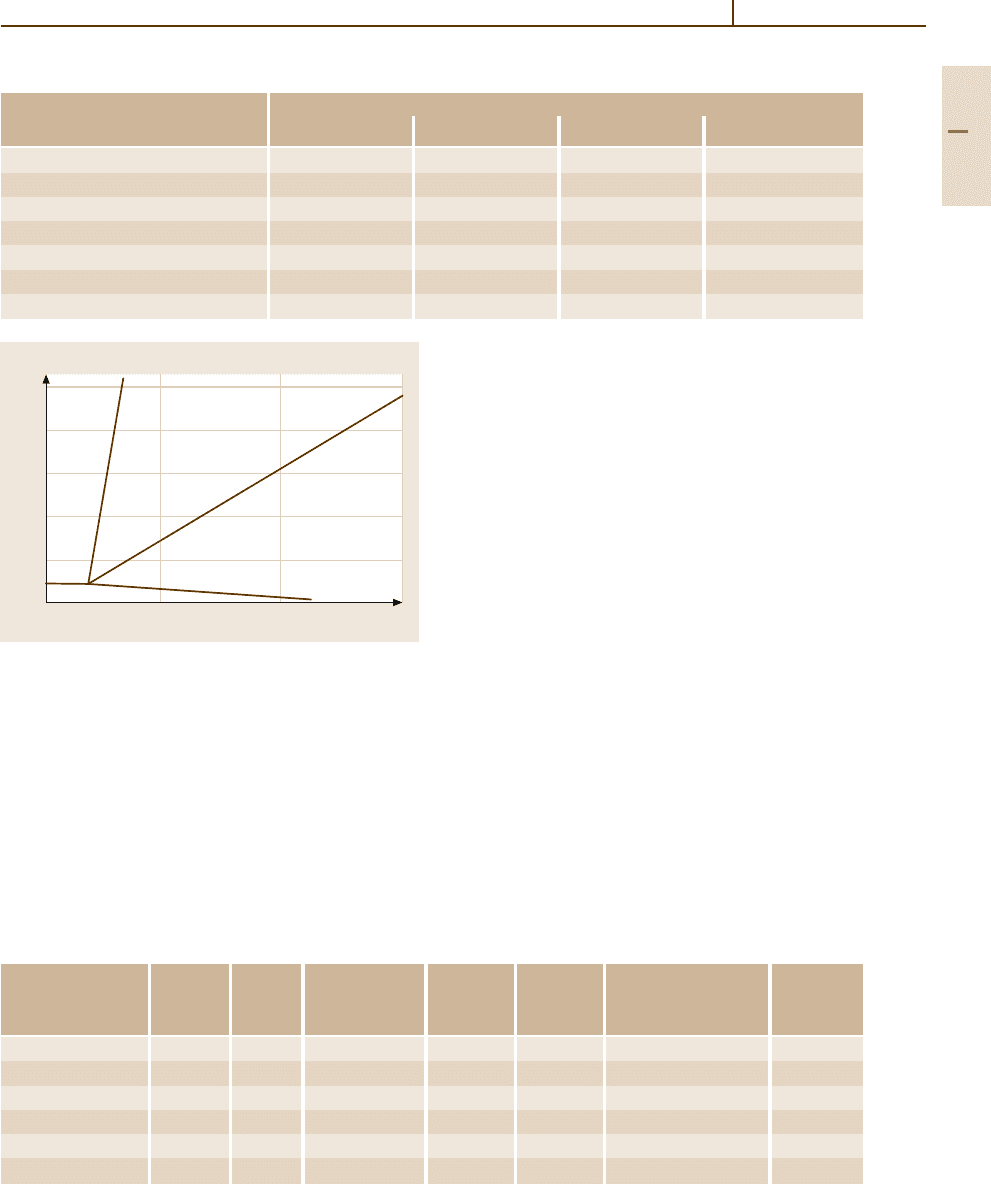
Metals 1.11 Lead and Lead Alloys 419
Table 3.1-289 Currently preferred compositions of automotive battery-grid alloys [1.307]
Manufacturing process; Composition (wt%)
grid type
Ca Sn Ag Al
Book mold cast; positive 0.03–0.06 0.5–0.9 0.010–0.045 0.01–0.02
Book mold cast; negative 0.09–0.13 0–0.3 Trace 0.015–0.03
Rolled, expanded; positive 0.06–0.08 1.2–1.6 Trace 0.003–0.008
Rolled, expanded; negative 0.06–0.08 0–0.5 Trace 0.003–0.008
Concast strip, expanded; positive 0.03–0.06 0.4–0.6 0.03–0.045 0.005–0.010
Concast strip, expanded; negative 0.07–0.1 0–0.2 Trace 0.005–0.010
Continuously cast; negative 0.07–0.1 0–0.3 Trace 0.005–0.010
0.20
0.16
0.12
0.08
0.04
Ca (wt %)
Sn (wt %)
1
2
3
α+Pb
3
Ca
α+Pb
3
Ca+Sn
3
Ca
α+Sn
3
Ca
α
Fig. 3.1-357 Suggested phase relations of Pb-rich
Pb
−
Ca
−
Sn alloys [1.310]
quired in negative grids to provide the corrosion and
creep resistance. The Ca content in positive grids
is lower than in negative grids to reduce corrosion.
Table 3.1-289 presents the compositions of Pb
−
Ca
−
Sn
alloys currently preferred in lead acid automotive bat-
teries [1.307]. Table 3.1-290 presents mechanical and
properties of commonly used Pb
−
Ca
−
Sn battery al-
loys [1.299,306].
Table 3.1-290 Properties of some of selected Pb
−
Ca
−
Sn battery-grid alloys [1.299,300]
Alloy composition Liquidus Solidus Ultimate tensile Elongation Hardness Coefficient Resistivity
strength of thermal
(wt%) (
◦
C) (
◦
C) (MPa) (%) (HR) expansion (10
−6
K
−1
) (n m)
Pb
−
0.065Ca
−
0.7Sn 327 219
Pb
−
0.065Ca
−
1.3Sn 323 26.6 220
Pb
−
0.07Ca 328 36–39 35–40 70–80 30.2 218
Pb
−
0.1Ca
−
0.3Sn 338 328 41–45 20–35 90–95 219
Pb
−
0.1Ca
−
0.5Sn 336 327 44.8–51.7 25–35 85–90 219
Pb
−
0.1Ca
−
1Sn 332 325 52–55 20–35 90–95 212
3.1.11.5 Pb–Bi Alloys
Pb–Bi Binary Alloys
Even though the relative difference of atomic radii
of Bi (1.56) and Pb (1.75) amounts to about 12%,
the solubility of Bi reaches 23.5 wt% at 184
◦
Cand
7.5 wt% at room temperature. While Bi addition has
very little influence on mechanical properties, Pb
−
Bi
alloys’ excellent wetting properties make them valu-
able as solders for glass-to-metal joints. Their desirable
solidification shrinkage characteristics and casting prop-
erties (that provide an ability to reproduce surface
details) make them useful in printing and prototyping
applications.
The Pb
−
Bi alloy system exhibits behavior of an
eutectic between an hcp intermetallic β phase and the
Bi terminal phase at 56.5 wt% Bi and 125
◦
C. Both Pb
and Bi have low cross sections for neutron absorp-
tion such that these alloys are attractive in heat transfer
applications in nuclear reactor systems [1.299].
Fusible Alloys
Lead forms a number of extremely useful low-melting
alloys when combined with Bi, Sn, Cd, or a combination
of these metals. The metals In, Sb, and Ag are also
Part 3 1.11

420 Part 3 Classes of Materials
added in some of the alloys. Some of these alloys melt at
a temperature lower than the boiling point of water, and
those containing appreciable amounts of Bi (> 55 wt%)
expand slightly upon solidification.
The melting point of the Pb
−
Sn
−
Cd ternary eutectic
is only 145
◦
C. By the addition of Zn, a quaternary eu-
tectic can be obtained with a melting point of 138
◦
C
at a composition of Pb–16.7 wt% Cd–52.45 wt% Sn–
2.25 wt% Zn. A further effective decrease in the melting
point is obtained by additions of Bi to Pb
−
Cd
−
Sn
alloys. The quaternary Bi
−
Pb
−
Cd
−
Sn eutectic has
a melting point of about 70
◦
C and a composition of Pb–
50 wt% Bi–12.5 wt% Cd–12.5 wt% Sn (Wood’s metal).
The phases of the quaternary eutectic are solid so-
lutions corresponding to the Pb, Sn, and Cd phases,
as well as and the β-phase of the Pb
−
Bi system.
The quaternary Pb
−
Bi
−
Sn
−
Cd eutectic alloy is brit-
tle when cast, and becomes ductile on storage for
two to three hours. The melting point of the quater-
nary eutectic alloy can be further lowered to 47
◦
Cby
additions of In. Addition of Hg instead of In could
also lower the melting point of Pb
−
Bi
−
Sn
−
Ca eu-
tectic but is not used due to its high vapor pressure
Table 3.1-291 Compositions and properties of selected fusible alloys [1.299,300]
Alloy Liquidus Solidus Vol ume Density Conductivity Coefficient Specific Latent Thermal
composition
a
change on of thermal heat heat conductivity
freezing expansion of fusion
(wt%) (
◦
C) (
◦
C) (vol.%)
b
(g cm
−3
) (% of IACS) (10
−6
K
−1
) (Jkg
−1
K
−1
) (kJ kg
−1
) (Wm
−1
K
−1
)
Pb
−
42Bi
−
11Sn
−
9Cd 88 70 2 9.45 4 24 168 23 21
Pb
−
42.9Bi
−
5.1Cd
−
43 38
7.9Sn
−
4Hg
−
18.3In
Pb
−
44.7Bi
−
5.3Cd
−
47 47 1.4 8.85 4.5 147 14
8.3Sn
−
9.1In
ASTM Alloy 117
Pb
−
48Bi
−
14.5Sn
−
9Sb 227 103 1.5 9.50 3 22 189
Pb
−
49Bi
−
21In
−
12Sn 58 58 1.5 8.60 3 134.4 21
ASTM Alloy 136
Pb
−
50Bi
−
9.3Sn
−
6.2Cd 70 78
Pb
−
50Bi
−
10Cd
−
13.3Sn 70 70 1.7 9.40 4 22 168 32
ASTM Alloy 158
Pb
−
51.7Bi
−
8.1Cd 92 92 10.25
Pb
−
52.5Bi
−
15.5Sn 96 96 9.71
ASTM Alloy 203
Pb
−
55Bi 124 124 1.5 10.30 3 126 16 16.8
ASTM Alloy 255
a
Alloys may contain small amounts of Ag, Cu, Sb and Zn
b
Positive values indicate expansion on freezing
and toxicity. In addition to the above quaternary eu-
tectic alloys, alloys of the ternary-Pb
−
Bi
−
Sn system
are also of great technical importance. One of these
alloys is the Newton-metal (Pb–50 wt% Bi–20 wt% Sn)
that has approximately the ternary eutectic composi-
tion. The melting temperature of this eutectic alloy is
90
◦
C. Another important alloy is Rose’s metal, with
a composition Pb–50 wt% Bi–25 wt% Sn and a melt-
ing temperature of 100
◦
C. Table 3.1-291 presents the
compositions and properties of selected fusible al-
loys [1.299,300].
Low melting alloys are employed in safety devices
such as sprinkler systems and boiler plugs, as special sol-
ders where high temperatures cannot be used, hermetic
seals for molds, patterns, punches and dies, for anchor-
ing punches in punch plates, and for bending tubing
(Table 3.1-292).
3.1.11.6 Pb–Ag Alloys
The addition of Ag to Pb in the range of 0.01–0.1wt%
provides high resistance to recrystallization, grain re-
finement, and high creep strength. Eutectic Pb
−
Ag
Part 3 1.11
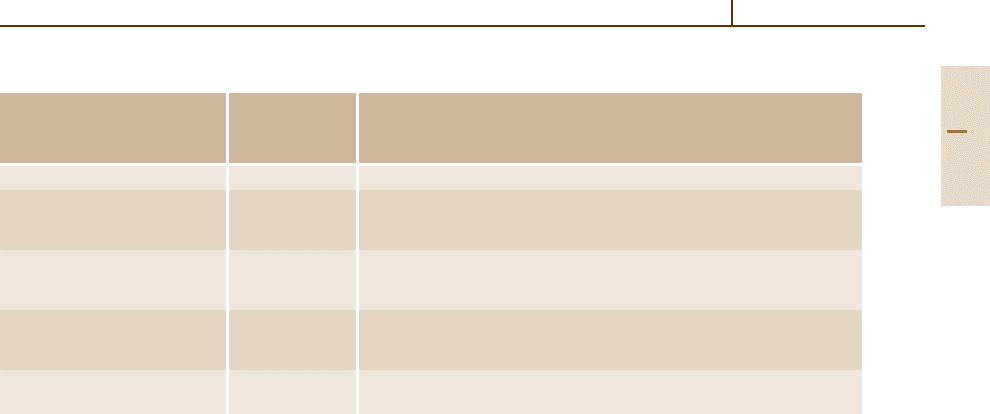
Metals 1.11 Lead and Lead Alloys 421
Table 3.1-292 Typical applications of some common fusible alloys [1.299,300]
Alloy Melting Typical applications
temperature
(
◦
C)
ASTM 117 47 Dental models, part anchoring, and lens chucking
ASTM 158 (Woods metal) 70 Bushings and locators in jigs and fixtures, lens chucking, reentrant tooling,
founding cores and patterns, light sheet-metal embossing dies, tube bending,
and Wood’s metal-sprinkler heads
ASTM 255 124 Inserts in wood, plastics, bolt anchors, founding cores and patterns, emboss-
ing dies, press-form blocks, duplicating plaster patterns, tube bending, and
hobbyist pans
ASTM 281 138 Locator membersin tools and fixtures,electroforming cores, diesfor lost-wax
patterns, plastic casting molds, prosthetic development work, encapsulating
avionic components, spray metalizing, and pantograph tracer molds
Pb–48 wt% Bi–14.5 wt%Sn–
9wt%Sb
103–217 Punch and die assemblies, small bearings, anchoring for machinery, tooling,
forming blocks, and stripper plates in stamping dies
alloys containing about 2.5 wt% Ag are used as soft sol-
ders of high melting point. The alloy Pb–0.1wt%Ag
is used as a precoat to metallurgically bond lead to
steel. Alloys of Pb–0.8–1 wt% Ag are used as insol-
uble anodes for electrowinning of metals from leach
solutions and for electrogalvanizing. The alloys Pb–
6 wt% Sb–1 wt% Ag, Pb–1 wt% Ag, Pb–2 wt% Ag, and
Pb–1 wt% Ag–1 wt% Sn are used as anodes for cathodic
protection.
3.1.11.7 Pb–Cu, Pb–Te, and Pb–Cu–Te Alloys
Maximum solubility in Pb is very low for both Cu
(< 0.007%) and Te (< 0.005%). Copper contents of less
than 0.1% provide considerable grain refinement and
structural stability at high temperature. Pb
−
Cu alloys
are used in cable sheathing and chemical applications.
A Te content of 0.01% refines and stabilizes the grain
size and increases the work-hardening in Pb
−
Te alloys.
Significant age-hardening is also obtained from super-
saturated solid solutions containing up to 0.1 wt% Te.
The optimal Te content is 0.04–0.05% with Cu addi-
tion of 0.06%. Alloys of Pb
−
Te have very high fatigue
strengths and are used in cable sheathing, radiation
shielding, and steam-heating coil applications.
3.1.11.8 Pb–As Alloys
The alloy Pb–0.85wt% As has very low volume shrink-
age on solidification and pore free castings obtained
with this alloy are used in radiation protection applica-
tions. Arsenic is added in Pb
−
Sb alloys to accelerate age
hardening. It is also used in Pb cable sheathing alloys to
enhance the bending and creep resistance.
3.1.11.9 Lead Cable Sheathing Alloys
Lead alloys are used as cable sheath in the construction
of electrical cables for communication and high voltage
transmission. The cable sheath serves as an imperme-
able barrier to prevent access of moisture to the insulated
core, a containment of the oil or gas in oil- or gasfilled ca-
bles, and a ground to the power cables under short circuit
conditions. The sheaths need to be easily applied in long
lengths and should have good creep resistance, fatigue
resistance, corrosion resistance, and microstructural sta-
bility. Table 3.1-293 lists some of cable sheathing alloys
and their typical applications.
3.1.11.10 Other Lead Alloys
Alloys of Pb
−
Li are attractive in some nuclear shielding
applications due to their ability to thermalize neutrons.
Lead containing more than 0.5 wt% In wets glass, and
Pb
−
In alloys with up to 5 wt% In can be used for sol-
dering glass over a narrow temperature range. Additions
over 25 wt% of In are made to Pb
−
Sn solders to in-
crease their alkali resistance. An addition of 1–2 wt% In
in Pb
−
Ag solders increases their strength. Indium is also
used in multi-component fusible alloy systems.
Part 3 1.11
